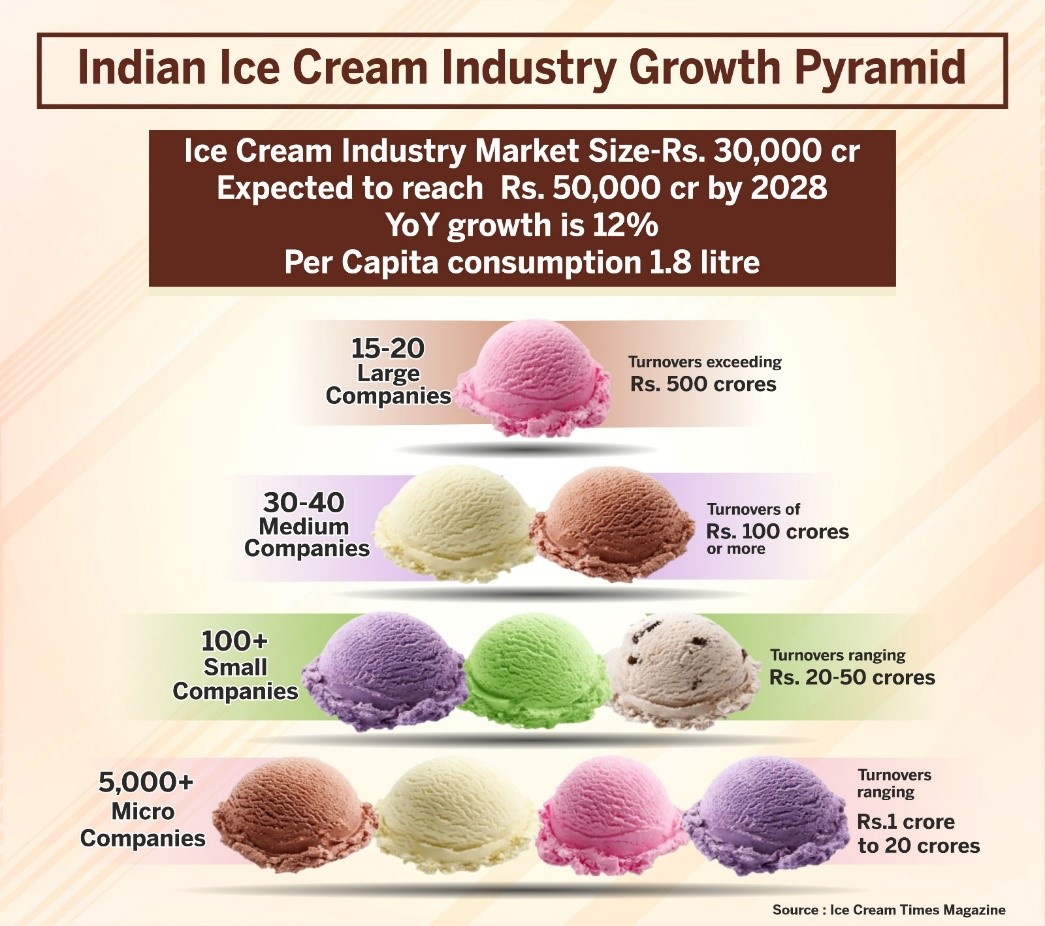
1.Introduction
The Indian ice cream industry is witnessing substantial growth, fuelled by rising consumer demand, evolving lifestyle preferences, and increasing disposable incomes. This report provides an overview of the industry’s current status, growth prospects, and potential opportunities. This report is based on the assumptions calculated with industry experts. This report provides insights into the industry collected from organized and unorganized players in the business.
2.Market Overview
The Indian ice cream market, valued at approximately INR 30,000 crore (USD 2 billion) as of March 2023, is expected to grow at a CAGR of around 10-12% over the next five years. Key factors driving this growth include a young population, an expanding middle class, urbanization, and a shift towards premium and innovative ice cream products. Per capita consumption of ice cream in India is crossing 1.8 litres.
3.Key Drivers of Growth
3.1. Increasing Disposable Incomes: With rising incomes, consumers are more willing to spend on premium and indulgent ice cream products, particularly in urban areas.
3.2. Changing Consumer Preferences: There is a growing preference for novel flavours, health-conscious options, and premium products, including gelato, frozen yoghurt, and low-fat ice creams.
3.3. Urbanization and Lifestyle Changes: Urbanization has led to a higher demand for ready-to-eat and convenience foods, including ice cream. Modern retail formats and online delivery services have also made ice cream more accessible.
3.4. Expansion of Retail Networks: The proliferation of modern retail outlets, such as supermarkets, hypermarkets, and convenience stores, along with e-commerce platforms, has enhanced product availability and visibility.
4.Market Segmentation
4.1. By Type: The market is segmented into impulse ice cream (bars, cones), take-home ice cream (tubs, boxes), and artisanal ice cream.
• Impulse Ice Cream: This segment holds the largest market share due to its convenience and affordability.
• Take-Home Ice Cream: Growing steadily as families prefer larger quantities for home consumption.
• Artisanal Ice Cream: A niche but rapidly expanding segment, driven by consumer interest in unique and
high-quality ingredients.
4.2. By Flavour: Traditional flavours like vanilla, chocolate, and mango dominate, but there is an increasing demand for exotic and fusion flavours.
4.3. By Distribution Channel: Includes supermarkets and hypermarkets, convenience stores, ice cream parlours, and online platforms. Online sales are growing due to the convenience and variety offered.

5. Market Size and Growth Rate
The Indian ice cream industry consists of two main segments: ice cream and frozen desserts. Both segments are subject to the same food safety and taxation regulations and are typically produced by the same manufacturers using similar processes, with variations in some ingredients. As of March 2023, the combined market size of these segments was estimated to be around INR 30,000 crore. The sector is growing at a rate of 10-12% year on year and is projected to reach INR 50,000 crore by 2028.
6. Market Proportion and Manufacturers
The Indian ice cream industry is substantial and growing. Impulse ice cream, which includes single-portion, ready-to-consume products, dominates the market due to India’s hot climate and the year-round demand for convenient treats.
The industry comprises around 7,000-8,000 manufacturers, including large, medium, small, and micro-scale producers. Approximately 15-20 companies have turnovers exceeding INR 500 crore, about 30-40 companies have turnovers of INR 100 crore or more, and over 100 companies have turnovers ranging from INR 20-50 crore. The largest segment consists of over 5,000 small and micro-level manufacturers with turnovers ranging from INR 1 crore to 20 crores.
7.Report on the Indian Ice Cream Industry
As of 2023, the Indian ice cream industry boasts a substantial turnover of INR 30,000 crores. With a robust annual growth rate of 12%, this dynamic sector is poised for remarkable expansion. Projecting this growth trajectory forward, the industry is expected to reach an impressive turnover of approximately INR 50,000 crores by 2028.
The per capita consumption of ice cream in India currently stands at 1.8 liters per year. While this figure is relatively modest compared to global standards, it highlights significant potential for growth. Increasing disposable incomes, urbanization, and evolving consumer preferences are driving demand, presenting vast opportunities for market players.
The industry is composed of a diverse mix of companies, ranging from large corporations to numerous small and regional manufacturers. Major players such as Amul, Kwality Wall’s (Hindustan Unilever), Mother Dairy, Vadilal, Arun, and Havmor dominate the market, leveraging extensive distribution networks and strong brand equity. These companies continue to innovate with new flavours and product formats, catering to the diverse tastes of Indian consumers.
Small and medium enterprises (SMEs) also play a crucial role in the industry’s landscape. There are approximately 5,000 SMEs, each with turnovers varying from INR 2 crores to 20 crores, contributing significantly to the market’s vibrancy and regional diversity.
Looking ahead, the Indian ice cream market’s growth prospects remain optimistic. Factors such as the introduction of premium and health-oriented products, expanding rural markets, and advancements in cold chain infrastructure are expected to further propel the industry. Additionally, foreign direct investment (FDI) and the entry of multinational brands will likely enhance competition and innovation.
In conclusion, with a current turnover of INR 30,000 crores and a projected rise to over INR 50,000 crores by 2028, the Indian ice cream industry stands as a testament to the country’s growing consumer market and its appetite for diverse and quality ice cream products.
8.The top 3 regions in India with significant market share
8.1. Maharashtra and Gujarat (Western Region): These states hold a larger market share due to favourable factors such as climate, higher per capita income, and urbanization.
8.2. Uttar Pradesh, Delhi, and Punjab (Northern Region): This state has a significant market share due to its large population and increasing urbanization.
8.3. Karnataka and Telangana (Southern Region): These states perform well in the market, driven by increasing urbanization and rising incomes.
9.Value Addition at Manufacturer Level
The Indian ice cream industry typically experiences a value addition of approximately 40–50% of the outward sale price. This includes costs related to raw material procurement, manufacturing, packaging, distribution, and marketing, reflecting the proportion of the final sale price attributable to the transformation and added value provided by the manufacturing process.

10. Top 10 Brands
10.1. Amul (Gujarat Co-operative Milk Marketing Federation Ltd.): Leading the market with its extensive
distribution network and strong brand reputation.
10.2. Hindustan Unilever Limited (HUL): Known for its popular brand Kwality Wall’s, leveraging its vast FMCG
experience and resources.
10.3. Mother Dairy: A subsidiary of the National Dairy Development Board, known for its quality and wide range of
products.
10.4. Creambell (Devayani Food Industries Ltd.): Recognized for innovative flavours and aggressive marketing.
10.5. Vadilal: A long-standing presence with diverse product offerings and strong brand loyalty.
10.6. Havmor: Part of LOTTE Wellfood Co. Ltd., with a significant presence and premium offerings.
10.7. Dinshaw’s: Strong in Maharashtra, Madhya Pradesh, and Chhattisgarh, known for quality and innovation.
10.8. Top ‘N Town (Ramani Ice Cream Company Limited): Particularly strong in central India with a diverse product
range.
10.9. Baskin Robbins (Graviss Foods Pvt Ltd.): Catering to the higher-end market with premium ice creams and
unique flavours.
10.10.Arun Ice Creams (Hatsun Agro Product Ltd.): Dominant in South India with a loyal customer base and wide
distribution network.
11.Opportunities for Allied Sectors in the Indian Ice Cream Industry
The growth and expansion of the Indian ice cream industry present numerous opportunities for allied sectors, including ice cream processing machinery, automation, packaging machinery and materials, cold chain logistics, freezers, and various ingredients. This section outlines the potential for these sectors to benefit from the rising demand for ice cream products in India.
11.1. Ice Cream Processing Machinery and Automation
11.1.1. Increased Demand for Advanced Machinery: As ice cream manufacturers look to enhance production efficiency and product quality, there is a growing need for advanced processing machinery. This includes homogenizers, pasteurizers, freezers, and mixers.
11.1.2. Automation: The shift towards automation in ice cream production processes can help manufacturers increase production capacity, reduce labour costs, and maintain consistent product quality. Automated systems for ingredient mixing, freezing, and packaging are in high demand.
11.1.3. Customization and Innovation: Manufacturers are seeking customized machinery solutions to cater to their specific product lines, including those for artisanal and premium ice creams. Companies offering innovative and flexible machinery will find significant opportunities.
11.2. Packaging
Machinery and Packaging Materials
11.2.1. Sustainable Packaging: With increasing environmental awareness, there is a growing demand for eco-friendly and sustainable packaging solutions. Companies providing biodegradable, recyclable, and reusable packaging materials will benefit from this trend.
11.2.2. Innovative Packaging Solutions: Consumers are drawn to visually appealing and functional packaging. Innovations such as tamper-evident seals, easy-to-open containers, and portion-controlled packs are gaining popularity.
11.2.3. Packaging Machinery: The demand for advanced packaging machinery, including automated filling and sealing machines, is rising as manufacturers look to improve efficiency and reduce packaging costs.
11.3. Cold Chain Logistics and Freezers
11.3.1. Cold Chain Solutions: Efficient cold chain logistics are crucial for maintaining the quality and safety of ice cream products. There is a growing need for temperature-controlled storage and transportation solutions.
11.3.2. Temperature-Controlled Packaging: Innovations in temperature-controlled packaging, such as insulated containers and refrigerants, help maintain the required temperature during transit, ensuring product integrity.
11.3.3. Freezers: The demand for commercial freezers, including display freezers for retail outlets and storage freezers for distribution centers, is increasing. Companies offering energy-efficient and reliable freezer solutions have significant growth potential.
11.4. Ice Cream Ingredients
11.4.1. Flavours and Colours: There is a rising demand for natural and exotic flavours and colours. Suppliers of high-quality, natural, and innovative ingredients will find ample opportunities.
11.4.2. Emulsifiers and Stabilizers: These ingredients are essential for maintaining the texture and shelf life of ice cream. Suppliers of high-performance emulsifiers and stabilizers can cater to the growing needs of manufacturers.
11.4.3. Dry Fruits and Nuts: The inclusion of premium ingredients like dry fruits and nuts in ice cream products is increasing. Suppliers offering high-quality and hygienically processed nuts and dry fruits will benefit from this trend.
11.4.4. Skimmed Milk Powder and Fresh Milk: The demand for high-quality dairy ingredients is rising as manufacturers aim to improve the nutritional value and taste of their products. Suppliers of fresh milk and milk powders will find significant opportunities.
11.4.5. Chocolate: The use of chocolate in various forms, such as chips, coatings, and sauces, is popular in ice cream products. Suppliers of high-quality chocolate and cocoa products can capitalize on this demand.
12.Opportunities for Foreign Companies and FDI in the Indian Ice Cream Industry
The Indian ice cream market presents numerous opportunities for foreign companies and investors, driven by the sector’s rapid growth and evolving consumer preferences. This section outlines the potential for foreign direct investment (FDI) and the entry of multinational brands into the Indian market.
12.1. Entry of Multinational Brands
12.1.1. Nestlé: Known for its global presence and diverse product portfolio, Nestlé can leverage its expertise to introduce new and innovative ice cream products in India.
12.1.2. Unilever (Magnum): With its premium brand Magnum, Unilever can tap into the growing demand for indulgent and high-quality ice cream products.
12.1.3. General Mills (Haagen-Dazs): Renowned for its premium ice cream offerings, General Mills can cater to the affluent consumer segment in India.
12.1.4. Lotte Confectionery: With its strong presence in Asia, Lotte can introduce its popular ice cream products to the Indian market.
12.1.5. Danone: Known for its dairy expertise, Danone can explore opportunities in the health and wellness segment of the ice cream market.
12.1.6. Mars (M&M’s, Snickers): Mars can leverage its popular confectionery brands to create innovative ice cream products that resonate with Indian consumers.
12.1.7. Ferrero (Raffaello, Kinder): Ferrero can introduce its premium and innovative ice cream offerings, targeting the high-end market segment.
12.2. Foreign Direct Investment (FDI) Opportunities
12.2.1. Joint Ventures and Partnerships: Foreign companies can enter the Indian market through joint ventures and partnerships with local manufacturers, leveraging their market knowledge and distribution networks.
12.2.2. Greenfield Investments: Establishing new manufacturing facilities in India allows foreign companies to benefit from local resources and cater to regional demands.
12.2.3. Mergers and Acquisitions: Acquiring or merging with existing Indian ice cream companies provides quick entry into the market and access to established brands and distribution channels.
12.3. Regulatory Environment and Ease of Doing Business
12.3.1. Favourable FDI Policies: The Indian government has implemented favourable FDI policies, allowing 100% FDI in the food processing sector, including ice cream manufacturing.
12.3.2. Food Safety and Standards: Adhering to the Food Safety and Standards Authority of India (FSSAI) regulations ensures the safety and quality of ice cream products, building consumer trust.
12.4. Infrastructure and Supply Chain Development
12.4.1. Cold Chain Infrastructure: Investing in cold chain infrastructure, including storage and transportation, ensures the quality and shelf life of ice cream products.
12.4.2. Distribution Networks: Developing robust distribution networks enhances product availability and market reach, especially in rural and semi-urban areas.
Manufacturing Process
13.1. Mixing Ingredients: Combining raw materials like milk, cream, sugar, stabilizers, and flavours.
13.2. Pasteurization: Heating the mixture to eliminate pathogens and ensure safety.
13.3. Homogenization: Breaking down fat molecules to create a smooth texture.
13.4. Cooling: Lowering the temperature of the mixture to prepare for ageing.
13.5. Ageing: Allowing the mixture to rest to improve texture and flavour.
13.6. Freezing: Rapidly freezing the mixture while incorporating air to achieve the desired consistency.
13.7. Adding Inclusions: Mixing in ingredients like fruits, nuts, and chocolate chips.
13.8. Packaging: Filling the ice cream into containers for retail distribution.
13.9. Hardening: further freezing the packaged ice cream to stabilize its structure.
13.10. Storage and Distribution: Maintaining the product at appropriate temperatures until it reaches consumer.
14.Conclusion
The allied sectors of the Indian ice cream industry are poised for substantial growth, driven by the expanding market for ice cream products. Companies involved in processing machinery, automation, packaging, cold chain logistics, freezers, and ingredients can capitalize on this growth by offering innovative, high-quality, and sustainable solutions. As the industry continues to evolve, the demand for advanced technology, functional ingredients, efficient logistics, and high-quality inclusions will create significant opportunities for these sectors.
The Indian ice cream industry is poised for robust growth, driven by favourable demographic trends, rising incomes, and evolving consumer preferences. Companies that innovate in product offerings, expand their distribution networks, and address logistical challenges will be well-positioned to capitalize on the market’s potential. The focus on premium products, health and wellness, and rural penetration will be key drivers for future growth.
15. Disclaimer
This report provides an overview of the Indian ice cream industry’s current status, growth prospects, and potential opportunities. The insights and data presented are based on assumptions and calculations made in consultation with industry experts. The information has been collected from both organized and unorganized players in the business to offer a comprehensive perspective. While every effort has been made to ensure the accuracy and reliability of the information, the report does not guarantee the completeness or future performance of the industry. Readers are advised to use this report for informational purposes only and conduct their own research or seek professional advice before making any business decisions.
16.References
16.1. Various articles, interviews, and reports are published in the Ice Cream Times, a monthly magazine.
16.2. Inputs from www.agronfoodprocessing.com, a prominent news portal.
16.3. Inputs by Firoz Haider Naqvi, publisher of Ice Cream Times and organizer of the Indian Ice Cream Expo.
16.4. IMARC Group. “Indian Ice Cream Market Report 2023.” Available at the IMARC Group website.
16.5. Mordor Intelligence: “India Ice Cream Market: Growth, Trends, COVID-19 Impact, and
16.6. Forecast Amul, “Annual Report 2023.” Gujarat Co-operative Milk Marketing Federation Ltd.
16.7. Hindustan Unilever Limited, “Annual Report 2023.” Hindustan Unilever Limited.
16.8. Ministry of Food Processing Industries, “Report on the Indian Dairy Sector.” Government of India.
16.9. Food Safety and Standards Authority of India (FSSAI). “Guidelines on Food Safety.” is available at the FSSAI
website.
16.10.Business Standard, “Growth Prospects in the Indian Ice Cream Industry.” Published on March 15, 2023.
Available at: Business Standard.
16.11.Journal of Food Science and Technology, “Recent Advances in Ice Cream Production.” Published in April 2023.


